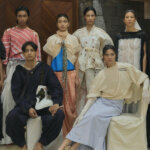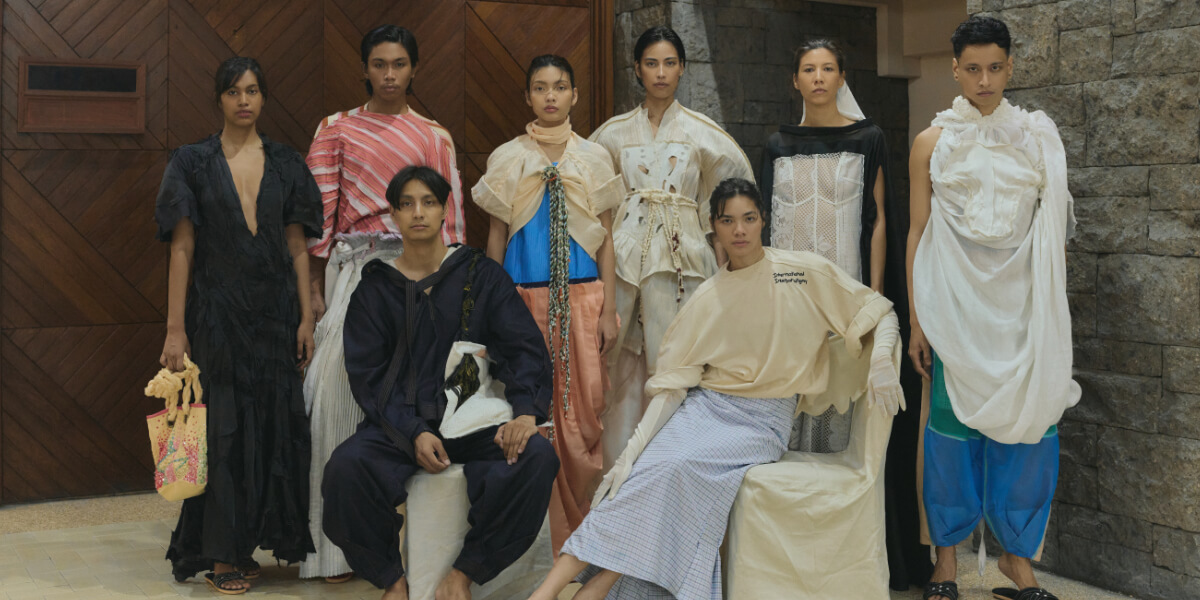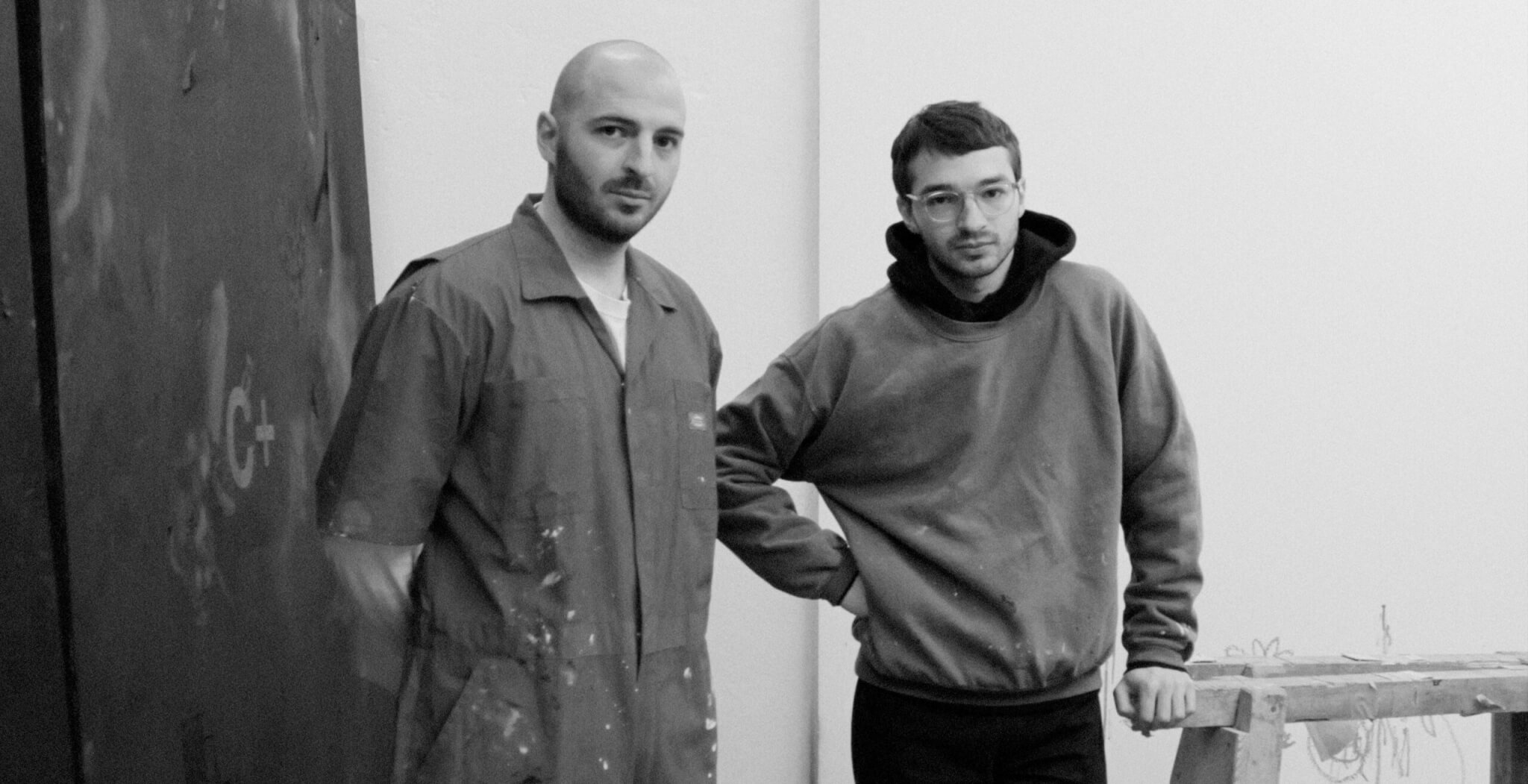Sunlight seeps through closed shutters, painting stripes onto a carpet. Fabric and a pair of scissors lay out on banana leaves. Rolls of green, blue, and beige fabric are stacked on top of each other. A little bouquet of flowers taped to a black satin shirt. A purple-reddish swirl of a sunset framed by high-rise buildings on both sides.
These are only a few impressions of the CarlJanCrewz camera roll, which the team behind the contemporary Filipino brand regularly uploads to Instagram. They set the tone for what their clothes embody: a nostalgia-laced exploration of the day-to-day aspects of Filipino life through certain silhouettes, colors, and fabrics. Carl Jan Cruz is the visual representation of wearing your heart on your sleeve, creating an honest dialogue between past and present, and a continuous evolution through seasons and time. An ethos that not only resonates with the fashion-forward and creative crowd in the Philippines but is gaining a steady audience worldwide, bringing Filipino designs to the showrooms of Paris, London, or New York.
“I would say that ‘Filipino design’ is not primarily an aesthetic but rather a sensibility”, explains CJ, who gave his name and irrevocably himself to the brand. “When you hear the Philippines, you think about the sun, the hustle and bustle, the food, beautiful and chaotic colors, and the unceremonious, unsynchronized movement. You think of functionality and utility, items that embrace an inherent Filipino-ness, like island slippers or the good morning towel. All of these things influence what Filipino design is and can be.”
Growing up in Manila, CJ became curious about fashion as a teenager and explored everything from styling and prop making to production assistance, before eventually pursuing fashion design in London. He interned for more established brands like Céline, where he realised how much he enjoyed the art of making clothes. The first Carl Jan Cruz collection in 2014 was part of CJ’s final year project.
“When I went back to London to submit the project, I realized that there was a lot of curiosity about where the clothes come from. A lot of people didn’t know much about the Philippines yet, so it became kind of a cultural introduction.”
For two years, CJ started making collections and selling personal orders, all the while building a team of twenty-five that now works so closely together with a sense of community based upon their shared heritage. “I’d say the first six years were kind of trial and error because we opted to do everything independently, from press outreach to showrooms,” CJ tells me.
Growing up as the child of an executive budget accountant, CJ had learned to combine his mother’s practicality with his own creativity to push his brand forward. “Everything from conceptualization to design has been formalized, and we’ve created different departments such as communications, marketing, design, and production. Even though I’m wearing this commercial hat, first and foremost, I’m a designer.”
The second person on our call is Maia, who has been doing marketing and communications at Carl Jan Cruz for about a year now. Before, she had been working at an art gallery and drew a lot of comparisons between the art and the fashion scene. Around the same time Maia joined the team, Carl Jan Cruz opened the doors to their store on 45 Bayani Road in Manila. It’s a place with lots of light, long curtains, soft-toned walls, dark woods, and green plants.
“Our location is kind of a destination, you don’t really stumble upon it”, Maia says. “We really like to interact with our clients and ask them how they heard about the brand and what made them want to come.” It feels like a place to come home to, a place where family gathers and where your clothes hug you gently. Just like the brand’s first ready-to-wear collection Pambahay, which was launched amid the COVID-19 pandemic.
The word is Tagalog for ‘house wear’, and the collection features lightweight, breathable fabrics, loose cuts, earthy tones, and the stripes that have become an integral part of the Carl Jan Cruz aesthetic. Pambahay is made from piqué, a fabric made from woven cotton yarn characterized by raised parallel chords. Together with the jerseys, it’s produced in the Philippines. “For special fabrics, we source a lot from countries that master their production, like silk from China or linen from South Asia. We don’t see ourselves as a mass-producing brand, so we like to focus on quality over quantity”, CJ states.
They stayed true to this ethos with their 2023 body of work, International Interbarangay, that married traditional Filipino techniques with modern design. “We used only small quantities of vintage and deadstock fabrics, so each piece was made in editions of three to six”, Maia details.
While Indigenous Filipino cultures used to operate on a more cyclical understanding of time that was closely tied to natural rhythms and agricultural cycles, Carl Jan Cruz has stopped doing seasonal collections. “We like to blur the lines between past, present, and future. Creating a new collection is an ongoing process, fueled by what we think is still missing and what we’d like to see”, CJ says. “With the International Interbarangay collection, you weren’t supposed to know if it’s old Filipino fashion or future Filipino fashion”, Maia adds. Part of what makes Carl Jan Cruz’s visual language so distinct is that the brand is very self-referential, drawing back onto a rich archive that keeps growing year after year.
CJ references American philosopher Richard Shusterman’s law of honesty, which requires the individual to make decisions without bias about themselves. “When I was doing all the technical research, such as colors, silhouettes, or textures, I was looking into my own personal archives and applying Shusterman’s methodology”, CJ recounts. “I questioned myself: why was I cuffing my trousers so much? Why was I wearing so many stripes? How would I style them in Manila and how in London? I was creating a visual autobiography.” The nostalgic sentiments stemming from this ongoing dialogue between personal past and present translate not only in the look and feel of the brand’s clothes but also in the community that has formed around it.
“Our medium will always be clothing, but that doesn’t mean that the people who consume and identify with our brand should only associate it with fashion. The legacy we want to leave is to contribute something for the culture.”
So who are the people shaping Filipino design and culture? Some of the trailblazers, whom CJ believes should be credited more, are Pitoy Moreno, Inno Sotto, Patis Tesoro, and Pepito Albert. Moreno was one of the earliest advocates of the Maria Clara gown, a traditional dress introduced to the Philippines during the Spanish colonial era. He was also known as the Fashion Czar of Asia and paved the way for young Filipino fashion designers through his work during the 1960s. Meanwhile, Patis Tesoro continues to reimagine the Filipina, her clothes rich in embroidery and embellishment.
Pepito Albert, on the other hand, was known worldwide for his striking designs with clean lines and attention to construction. “We’re grateful that we get to work side by side with a lot of creatives who are building the current voice of contemporary Filipino fashion,” CJ expresses. “And we’ve had the pleasure to host some of these collaborators at 45 Bayani.” He continues to mention designers Joey Samson, Renz Reyes, Prince Padilla, and her brand Novel, the footwear brand JOS MUNDO, streetwear label Proudrace, or the home item platforms fili and Ancán Store. The list could go on, displaying the hub of creativity present in the Philippines.
The country has a rich cultural history that CJ and his team like to draw on for inspiration. “The motion picture company Viva Films has been remastering a lot of Filipino films, making them accessible on YouTube”, CJ tells me. “We reference a lot of them, for example, the 1984 drama Working Girls.” It depicts the role of women in the new millennium and follows seven women of different backgrounds, stories, and personalities working in a commercial bank in Makati. The gallery ARCHIVO 1984 has curated a large selection of Philippine art, literature, film memorabilia, and OPM. Founded by a quiet archivist with a passion for collecting, it steps away from the idea of a traditional gallery and takes on a distinct personal approach to curation. “Family has influenced me a lot as well, especially my mother”, CJ adds. “And of course, my team and the conversations we have. When I started this brand, I was young and idealistic, thinking I could just start anew if anything goes wrong. Now that I’m not only responsible for myself, I still want to take risks but with accountability for my team.”
Interpersonal relationships play a big role in Carl Jan Cruz and what makes the brand feel so familial. Not long ago, they dressed fashion model Siobhan Moylan and Christian Tantoco for their wedding: a beautiful celebration rooted in heritage and love. In an interview with Tatler, Moylan talks about her appreciation of Carl Jan Cruz: “He’s able to translate Filipino heritage in a modern way, and I knew he could create something different for me. I liked the idea of wearing a non-traditional dress.” Her Mini Corset Tulip Dress is a tea-died second skin constructed through months of sculpting, distressing, and layering, paired with a beaded veil.
Tantoco’s Barong Blazer is a layered garment made of piña, mesh, and abaca silk, inspired by the traditional barong and infused with a new pattern and embroidery. “I’ve long been a fan of Carl Jan Cruz’s work, and wearing such a thoughtfully made barong by him was a dream”, the groom says. So far, Carl Jan Cruz has mostly been doing custom looks for friends and family. “It helps that there’s already a relationship”, CJ explains. “Doing customs requires a lot of familiarity and getting to know each other. There’s a great sense of mutual respect where we see them as ambassadors as to how our brand is being perceived. The more they wear them, the more I understand the clothes.”
This year marks the 10th anniversary of Carl Jan Cruz – ten years of growth, transformation, and capturing the essence of Filipino-ness. While this might be the brand’s overarching concept, the themes keep changing. “There’s no static look, but there’s always a feeling”, CJ describes. “I’m very satisfied to be part of the fabric of Filipino culture, and hopefully we can see that through to grow into something more. I hope that ten years from now, we still get to keep things exciting and intentional. We’re optimistic to share our energy with our community and the rest of the world and keep the dialogue alive.”




























